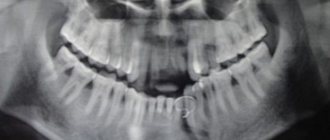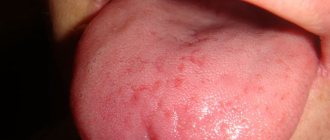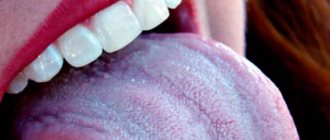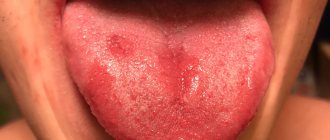Malocclusion
Incorrect bite formation leads to permanent injury to the mucous membranes of the mouth and tongue. As a result, the muscle organ swells and increases in size. Due to constant biting, teeth marks are left on the sides of the tongue.
The disease can be cured only after correcting the malocclusion. To do this, the doctor selects a design to straighten the dentition. For minor violations, patients are prescribed to wear orthodontic plates, trainers, and silicone trays. In case of more serious pathology, the defect is corrected using braces. The course of treatment can take from 3 months to 2 years.
Main non-dental causes
Tongue diseases
If you notice an enlarged tongue with teeth marks in yourself or your child, then you should look for the problem in inflammation of the muscle organ. Often the cause of the pathology is a disease such as glossitis. There are many types of glossitis: desquamative, allergic, herpetic, ulcerative, hypertrophic, folded - read in detail about all types and forms in the feature article on the website.
When glossitis appears, other characteristic symptoms usually occur, in addition to the fact that tooth marks remain on the tongue:
- burning and itching of the muscle organ,
- redness, the appearance of plaque of different shades,
- pain and discomfort when eating food, when communicating with others,
- change in relief and structure: formation of cracks, ulcers, grooves, spots, erosions.
The causes of glossitis are very diverse: injuries, weak immunity, active reproduction of viruses and bacteria in the oral cavity, allergic reactions to personal hygiene products, medications and food.
Xerostomia (dry mouth)
A swollen tongue with teeth marks is often noticed by people who have impaired normal salivation. Xerostomia can occur in older people, as well as in those who take various medications for a long time. In some cases, the pathology is associated with dysfunction and inflammation of the salivary glands, autoimmune diseases (for example, Sjogren's syndrome), and hormonal disorders.
Another reason is dehydration after diseases accompanied by intoxication and high body temperature (poisoning, sore throat, influenza, ARVI and many others). Xerostomia affects people with diabetes, as well as those who frequently smoke and drink alcohol.
On a note! Sometimes dry mouth is normal. For example, the rate of salivation naturally decreases at night, which is why many people notice bad breath and teeth marks on the tongue after sleep. The problem can also appear after exhausting physical activity, sports, prolonged stay in stuffy rooms and in the open sun.
With a lack of saliva, the muscular organ becomes dry, may turn red, swell and increase in size, after which imprints appear on it and cracks appear. There are other signs of xerostomia:
- halitosis: bad breath,
- viscous and thick saliva,
- difficulty chewing and swallowing dry food,
- thirst.
If the problem of chronic xerostomia is not addressed, caries will progress, as well as other dental diseases (erosions, gingivitis and periodontitis, candidiasis). After all, the lack of a sufficient amount of saliva leads to the active proliferation of bacteria in the oral cavity and increased accumulation of plaque on the enamel, gums, and also under the gums.
Nervous disorders and stress
Teeth imprints on the sides of the tongue may indicate excessive nervous excitability and that the person has recently been in a stressful or conflict situation, experienced severe psycho-emotional shock, or is in a depressed state. Under nervous overload, you can involuntarily clench your jaws, squeeze the muscular organ between the lower and upper jaws, bite it, after which marks appear on its surface.
In rare cases, the problem indicates neurological disorders and neuroses, epileptic seizures in which a person cannot control himself. But then the patient not only bites a muscle organ, but can severely injure it, disrupt the integrity of the mucous membrane and tissue covering it, and cause bleeding.
Malfunction of the hypoglossal nerve
When an organ is displaced and occupies an unusual location for it, then teeth marks appear on it, as in the photo. Such an unpleasant phenomenon may be associated with pathological damage to the hypoglossal nerve resulting from a massive stroke or multiple sclerosis.
Pathologies of the gastrointestinal tract
A dense plaque of white, yellow or brown color appears, and after closing the jaws, tooth marks remain on the tongue if there is any disease of the gastrointestinal tract: gastritis, ulcers, colitis, pancreatitis, dysbacteriosis, acidity disorders.
Usually, with these pathologies, the patient is accompanied by halitosis, and plaque cannot be permanently removed with a brush and paste, since it constantly accumulates again. There are other characteristic symptoms of gastrointestinal pathologies: bloating, pain, stool disturbances, nausea, heaviness in the abdomen.
Endocrine system dysfunction
If a muscular organ has increased in size and swollen, and there are imprints of chewing teeth on it, then what does this mean? Perhaps an advanced stage of hypothyroidism, when the thyroid gland does not secrete enough hormones. Patients with this disease usually notice not only swelling of the muscle organ, but also swelling of the face and neck. Their hair begins to grow and fall out, their nails peel, their diction is impaired, their blood pressure and pulse rise, arrhythmia occurs, and their voice becomes hoarse.
Acute deficiency of vitamin B3 and nicotinic acid
Due to the lack of these substances in the body, a rare form of vitamin deficiency develops, which doctors call pellagra. The disease is quite rare, because vitamin B3, as well as nicotinic acid, are contained in almost all products that we, one way or another, consume: eggs, milk, all types of meat, liver, fish, carrots, potatoes, tomatoes, wheat. Experts believe that the pathology mainly occurs in people from disadvantaged environments and those who abuse alcohol.
With pellagra, the muscle organ swells, and therefore teeth marks periodically appear on the tip of the tongue or on its sides. There is a feeling of discomfort and burning in the mouth, the mucous membranes and gums itch, hurt, and itch. This disease brings with it many others: dementia, dermatitis, nervous disorders, paralysis of the limbs, dysfunction of the cardiovascular system.
Important! Teeth imprints on the tongue may indicate various diseases: hemolytic anemia[1], scarlet fever, cancer, tuberculosis, HIV. A swollen muscle organ on which imprints remain is sometimes a consequence of acute allergic reactions and Quincke's edema.
Folded tongue
This is a congenital anomaly in which the tongue is excised by longitudinal and transverse folds, wavy, uneven at the edges. As a rule, the disease is accompanied by an increase in the size of the organ and its thickening; teeth marks can be seen on the sides. Usually the pathology is asymptomatic and does not cause discomfort; pain and inflammation can appear after infectious diseases, with the development of stomatitis or glossitis.
The folded tongue requires good hygienic care, since bacterial plaque easily accumulates in the cracks and creates a convenient environment for the proliferation of pathogenic bacteria. Such a disease is incurable; therapeutic procedures are necessary only when stomatitis and glossalgia develop.
Why do teeth marks appear on the tongue and what to do about it?
If you notice teeth marks on your tongue, then this symptom should alert you. We must not forget that the tongue is a mirror of the body. It is through this organ that signals about various pathologies and diseases that require treatment can be received. We will talk about the most common of them in our article today.
Liver diseases
In people suffering from serious liver diseases (viral hepatitis, cirrhosis of the liver), the tongue has a characteristic appearance - the mucous membranes are red, hyperemic, the surface is smooth, glossy, the papillae are smoothed. Often such symptoms are accompanied by swelling of the organ and an increase in its size, as a result of which the edges are constantly bitten by the teeth, forming wavy sides.
Among the additional external symptoms, patients note the appearance of spider veins, xanthomatous plaques, and erythema (redness) of the palms on the surface of the skin. Patients complain of pain in the right hypochondrium, nausea, vomiting, indigestion and stool disorders.
The disease must be treated by a general practitioner, infectious disease specialist, surgeon or oncologist.
Vitamin deficiency
If there is a lack of vitamins B and D in the human body, the surface of the tongue dries out, cracks, becomes inflamed, becomes coated, and bad breath appears.
When an allergic reaction to vitamins occurs, the muscular organ swells, and dents from the teeth are clearly visible on its lateral surfaces. With a lack of vitamin B₃, the organ cracks, painful sensations appear, and a burning sensation occurs while eating. If an infection occurs, an acute inflammatory process develops, purulent ulcers form, and the person’s well-being worsens. To treat the disease, it is necessary to compensate for the lack of vitamins in the body.
Hypothyroidism
This disease is caused by a malfunction of the thyroid gland. The pathology is manifested by swelling of the tongue with characteristic marks of teeth on its surface. Patients are inactive and find it difficult to talk due to dry mouth. There is a sensation of a foreign object in the mouth, the tongue becomes tangled.
External symptoms of the disease include a yellow tint to the skin, swelling of the face, increased hair loss, deterioration of memory and intellectual abilities, disruption of the digestive tract, and disorders of the genitourinary system. Hypothyroidism is treated by an endocrinologist.
Causes of a serrated tongue
A jagged tongue is not dangerous, and it is not a disease in itself, but a condition that is a consequence of other pathologies or diseases. The most common causes of a serrated tongue are:
Swollen tongue or macroglossia
“When your tongue swells, becomes too large for your mouth, puts pressure on your teeth and they leave their imprints on the sides of the tongue” [newsmax.com], edges become jagged .
A swollen tongue can be a consequence of allergies (in particular, angioedema), certain diseases and pathological processes: amyloidosis, hypothyroidism, tongue cancer, wounds and ulcers, scarlet fever, etc. Dehydration can also cause a swollen tongue and dry mouth.
Hypothyroidism
Thyroid hormone deficiency, which occurs due to underactive thyroid glands (hypothyroidism), can interfere with normal functioning of the body because “thyroid hormones regulate the way we use energy—metabolism—and without enough of these hormones, many body functions are significantly slowed down.” medicalnewstoday.com].
Additionally, if you produce little or no thyroid hormone, your face and tongue may become swollen. “When the face is severely swollen, swollen eyelids, thickened lips, and a swollen tongue may occur” [www.ito-hospital.jp]. And such a tongue is one of the reasons for the appearance of unevenness and jagged edges.
The most significant thyroid diseases for the appearance of a serrated tongue are Hashimoto's disease, thyroiditis and congenital hypothyroidism.
In addition to a jagged and swollen tongue, other symptoms develop with these pathologies:
- fatigue and general weakness;
- hoarseness of voice;
- hair thinning;
- dry skin;
- tendency to constipation;
- muscle pain;
- depression;
- increased sensitivity to cold, etc.
Therapy for serrated tongue for underactive thyroid includes:
- treatment of hypothyroidism using hormone replacement medications, which must be taken daily;
- eating foods rich in vitamin B;
- radiation therapy;
- psychological help for anxiety, stress, depression.
It is also possible to use non-traditional methods (acupuncture, naturopathic remedies and homeopathy, biofeedback (biofeedback), osteopathy) [womentowomen.com].
Temporomandibular joint syndrome
Tooth marks on the tongue
This is a pathological condition that occurs when the function of the temporomandibular joint, which connects the skull and lower jaw, is impaired. Occurs with injuries and significant constant sports loads, decreased bite height, and taking certain medications.
Main symptoms:
- teeth grinding (bruxism);
- headache;
- congestion, noise, ear pain;
- swelling of the sides of the face;
- painful chewing;
- clicking in the joint and subluxations.
In this situation, most people try to use the tongue to keep the jaw in a normal position. That is, if “the bite is incorrect, then to fix the jaw for swallowing ... the tongue presses on the teeth, stabilizing them” [mjtreatmentsc.com]. This can cause teeth marks and indentations on the tongue.
It's worth noting that if your tongue is not swollen, but has teeth marks, you may have a narrow lower jaw, or you have a habit of pressing your tongue too hard against your teeth.
Qi deficiency in the spleen
If your tongue is not only jagged, but also swollen and cracked, then according to Traditional Chinese Medicine, this indicates a lack of Qi (primary life energy) in the spleen. If this happens, the spleen is unable to perform its function in the digestive system, especially converting food into energy. And then the person begins to experience weakness and fatigue, pallor of the mucous membranes (including the tongue) and facial skin, poor appetite and weight loss in addition to a serrated tongue.
Sleep apnea
A possible cause of a jagged tongue is sleep apnea, which is “a common disorder in which one or more pauses in breathing occur during sleep, that is, brief stops in breathing” [nhlbi.nih.gov]. When there are pauses in breathing movements during sleep, the tongue often “sinks into the oral cavity,” and then its edges become uneven.
Bad habits
The development of certain habits, such as clenching the jaw or pressing the tongue tightly against adjacent teeth for a long time, can lead to uneven edges of the tongue. Anxiety can also cause people to press their tongue against their teeth because it causes increased muscle tension.
Deficiency of minerals and vitamins
Deficiency of folic acid and vitamin B12 causes excess production of abnormal red blood cells that do not function normally. This condition is known as megaloblastic anemia. This pathology can lead to swelling of the tongue. To solve this problem, you need to eat foods rich in vitamin B12 and folic acid, and also take medications containing these elements in doses and for a certain time prescribed by your doctor. In addition, iron deficiency can also cause changes. According to livestrong.com, "lack of iron can cause a swollen and jagged tongue... Meat, fish, poultry, fresh leafy greens, legumes and vitamin-fortified breakfast cereals can help meet your daily iron requirement" and prevent this phenomenon.
Painful cracks in the tongue
A tongue with jagged edges may also indicate the possibility of oral cancer, especially if there are painful cracks or sores. The likelihood of cancer is quite low, and it is usually accompanied by other symptoms.
Other reasons
A scalloped tongue that is pale or coated with a white coating may also indicate digestive problems or sinus disease.
Gastrointestinal diseases
The oral cavity and digestive organs are in direct communication. Diseases of the stomach and intestines cause acidity in the mouth, creating a convenient environment for the proliferation of bacteria. A persistent white or yellow bacterial coating appears on the surface of the tongue and mucous membranes, spots or erosions may form, the organ becomes inflamed and increases in size.
A symptom of the development of gastrointestinal diseases is the root of the tongue coated with plaque.
Peptic ulcers of the stomach, duodenum, duodenitis, dysbacteriosis, gastritis with high acidity, and colitis can cause such symptoms. Additionally, patients are bothered by abdominal pain, nausea, vomiting, heartburn, stool disorders, and flatulence.
To treat the pathology and eliminate plaque on the root of the tongue, you need to consult a gastroenterologist. During therapy, plaque and swelling disappear. If erosions have formed on the mucous membranes, it is necessary to do regular antiseptic mouth rinses with Chlorhexidine, Miramistin or Chlorophyllipt.
Nervous system diseases
With disorders of the nervous system, unpleasant painful sensations occur, tingling in the tongue, a disturbing feeling of dry mucous membranes, hyperesthesia, burning, disturbances of taste, diction, swelling and the appearance of bacterial plaque. This disease is called stomalgia, most often it affects women during menopause or after suffering shocks. Symptoms of the disease decrease with eating, especially when eating spicy foods. Unpleasant sensations are localized on the tip and sides of the swollen tongue, its edges are wavy, and dents from the teeth are visible.
The main causes of pathology are recently experienced tragic events in life: the death of relatives, cancer of loved ones, personal problems. Patients are easily excitable, constantly look at their tongue in the mirror, and are pathologically afraid of developing cancer.
Treatment of stomalgia is carried out comprehensively. It includes medication, psychotherapy, physiotherapy, acupuncture, and oral sanitation.
Uneven, wavy edges of the tongue may indicate the development of a serious illness. Therefore, if such a symptom appears, you should consult a dentist and therapist. Timely treatment will help avoid the development of severe complications.
Associated symptoms
People who have imprints of their front or chewing teeth on their tongue often notice other alarming signs indicating pathological conditions:
- the muscular organ swells and increases in volume, becomes inflamed, changes its color, cracks, sores, erosions and spots appear on it,
- plaque formation: the density of plaque may depend on various factors - time of day, stage of development of a particular disease, nature of food consumed, frequency and thoroughness of hygiene procedures,
- it is difficult and painful to eat food, swallow it, talk,
- displacement of the tongue to the side, inability to control its position.
Some experts believe that if prints appear on the tip of an organ, this may indicate excessive nervous excitability and stress. If on the sides, then most often it indicates malocclusion pathologies, dental problems, diseases of the gastrointestinal tract, and pathologies of the endocrine system.











